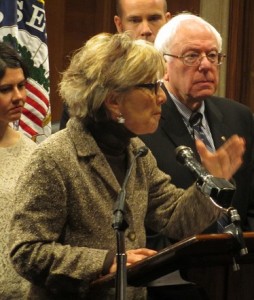One Who Would Know Says Republican Principles Require a (Revenue-Neutral) Carbon Tax (NYT Caucus Blog Interview w/ George Shultz)
Search Results for: revenue
The Many Benefits of a Carbon Tax
The Many Benefits of a Carbon Tax (Adele Morris, Brookings)
Sanders-Boxer Set “Gold Standard” But Write Off Fiscal Potential of Carbon Tax
One day after 48 climate protesters were arrested at the White House and three days before what is billed as “the largest climate rally in history,” Senators Bernie Sanders (I-VT) and Barbara Boxer (D-CA) set a new “gold standard” for transparent, effective climate legislation. Their Climate Protection Act (“CPA”) would impose an upstream carbon pollution fee starting at $20 per ton of CO2, rising in ten years to $33/T, and would tax methane emissions at their CO2 climate equivalency. Gone are “hide the price” gimmicks of cap-and-trade. No trading, offsets, banking, borrowing or allowance give-aways to polluters. Sanders-Boxer would return 60% of revenue directly to households monthly, allot 25% to deficit reduction and dedicate the remaining 15% to green energy, weatherization and infrastructure “hardening” under a companion bill, the Sustainable Energy Act. The CPA bill includes border tax adjustments to protect U.S. energy-intensive industry and nudge our trading partners to enact their own carbon pricing measures.
Opening a packed Capitol Hill press briefing yesterday morning, Sanders inveighed against partisan squabbling which he insisted must yield before the ineluctable laws of physics. Earlier scientific projections were wrong, Sanders said, “the crisis facing our planet is much more serious than they previously believed.” Sanders and Boxer conveyed alarming warnings of “global climate disruption” from a Senate Environment and Public Works Committee briefing on Wednesday. The panel of four scientists had concluded that without aggressive action, the earth will warm by 8 degrees Fahrenheit within a century, with consequences including 3 – 6 feet of sea level rise, more frequent and forceful damaging storms, drought, extreme crop loss and submerging of coastal cities.
At Thursday’s press briefing, climate activist-author and 350.org founder Bill McKibben thanked Sanders and Boxer for grasping the “depth of the climate problem” and moving to end the fossil fuel industry’s free dumping of pollution into the atmosphere. Sierra Club director Michael Brune, Public Citizen’s Tyson Slocum, Tara McGuiness of the Center for American Progress and Meg Power of the National Community Action Foundation all praised the effectiveness and fairness of the bills.
Reporters immediately questioned how the two bills could move forward. Boxer said she has just begun seeking co-sponsors and hasn’t conferred with Majority Leader Harry Reid about scheduling. But she expects to conduct hearings and markup in Environment & Public Works and to bring the measures to the Senate floor by summer. Replying to a question about EPA greenhouse gas regulations, she said, “We’ve beaten back” Republican repeal efforts. “The Clean Air Act is the law of the land” which the President “must carry out.” Boxer suggested that public opinion on climate is “far ahead” of Congress, “no one is asking for dirtier air or water.” But she offered no plans to reach across the aisle to enact their bills, either in the Democratic-controlled Senate or the Republican House. She called on environmental and public interest organizations to build support for climate legislation. Sanders suggested that the public hold accountable “Republicans who refuse to even recognize the reality of climate change.”
The Climate Protection Act certainly sets a high standard. By our lights, it’s the most potent climate legislation ever introduced in the Senate. The Carbon Tax Center gauges efficacy primarily by the price polluters would pay. Along with most economists, we are convinced that a briskly-rising price on CO2 pollution is hands down the most broadly-effective and potent force to reduce emissions and open the way for renewables, efficiency and innovation. While the CPA’s price trajectory isn’t nearly as aggressive as our own “gold standard,” Rep. John Larson’s 2009 bill (which we’ve been told he will reintroduce soon), we view CPA as a good start. We estimate Sanders-Boxer would reduce emissions by about 12% below 2005 levels in a decade. (In contrast, Rep. Larson’s more robust carbon price ramp-up would reduce emissions by 30% in the same time period.)
CPA’s proposed direct distribution of 60% of revenue would protect most low- and moderate-income households from the effects of energy price increases, without diluting incentives for everyone to reduce fossil fuel use. Its 25% share of revenue designated for deficit reduction (essentially compelled by Congressional Budget Office accounting rules) could appeal to deficit hawks. We’re less confident that energy subsidies would be well spent. But as Senator Sanders noted, home weatherization that cuts utility bills is like a permanent tax cut. Instead of subsidies, we recommend more revenue return to households to ensure growing public support for continued brisk increases in the price of carbon pollution needed to achieve scientifically-mandated emissions reduction in the range of (or exceeding) 80% by 2050. In British Columbia, dedicating carbon tax revenues to cutting a range of other taxes on work, business and consumption has marshaled public support for four annual carbon tax increases.
As we heard the press conference, Boxer and Sanders seem to have written off every member of the Republican caucus as a potential collaborator on climate policy. If that’s the case, they may be writing off this Congress and the opportunity that a looming sequester and debt ceiling crisis may present to shift taxes on productive activity to taxes on CO2 pollution.
It’s true that the House Republican leadership has pledged to reject any climate measure that generates revenue. But that may still leave room for revenue-neutral tax swaps. Kevin Hassett (American Enterprise Institute), Adele Morris (Brookings) and Donald Marron (Tax Policy Center) have suggested funding cuts in corporate income tax rates with a carbon tax. That kind of proposal should interest legislators like Ways & Means chairman Dave Camp who has repeatedly stated his desire to cut corporate income tax rates.
A proposal like Sanders-Boxer combined with one like those of Hassett, Morris and Marron could yield a broad and popular carbon tax swap like British Columbia’s. We simply can’t afford to give up on this Congress and wait any longer to start putting the brakes on global climate disruption.
Photo: Flickr– Public Citizen
The Newly Proposed Carbon Tax Will Fight Global Warming, Protect Low-Income Americans And Reduce The Deficit
Sanders-Boxer Carbon Tax Will Fight Global Warming, Protect Low-Income Americans, Reduce Deficit (Center for American Progress)
Could A Carbon Tax Be The Key To Achieving Corporate Tax Reform?
Could Corporate Tax Reform Be The Key To Enacting A Carbon Tax? (Donald Marron, Forbes)
Paul Ryan, go bold with carbon tax
Paul Ryan, Go Bold With Carbon Tax (Milwaukee Journal)
Kelly McParland: The stars align behind Alberta carbon tax
Stars Align Behind Alberta Carbon Tax (Kelly McParland, Nat’l Post – Canada)
Breaking News: Alaska Sen. Murkowski Rejects $450/ton Carbon Tax
The arguments being marshaled by U.S. Senator from Alaska Lisa Murkowski to reject either a carbon pollution tax or a carbon emissions cap are timeworn and easy to deflect. Equating more energy with prosperity (and less energy with deprivation) is so far behind the curve, it even got upended in a Super Bowl commercial. (OK, the spot only aired in the Tri-State New York region, but it still had a major car company pushing fuel efficiency with the punchline, “The only way to pay less for gas is to pay for gas, less.”)
What’s harder to absorb is Murkowski’s embrace of that equation at the dawn of the 113th Congress, when enacting a U.S. carbon tax requires at least a modicum of Republican support.
Murkowski, the ranking Republican on the Senate Energy Committee, has long been regarded as the Republican Senator most likely to someday go for a carbon tax. Back in 2007 she even co-sponsored a carbon cap-and-trade bill, in part because she understood that her state has been experiencing even more severe temperature upheavals than the other 49. Not to mention that the Alaska Permanent Fund’s pro rata distribution of North Slope oil royalties to households has become a model for the fee-and-dividend carbon tax approach.
All of which makes it confounding that, according to press reports, Murkowski’s new energy “blueprint” brings down the hammer on both carbon price disincentives and limits on fossil fuels:
A carbon tax or a cap and trade proposal or something that is going to make energy more expensive is not going to help us . . . We like to be comfortable in our temperatures. We like to be able to move around. This is the mark of a successful and an economically healthy world. Where you have energy these are the prosperous areas.
Those remarks are not from Murkowski’s energy blueprint, called Energy 20/20, which isn’t Web-available yet. They’re direct quotes from the Senator, from a carefully reported article last weekend in the Anchorage Daily News. The same article helpfully reminded readers that “Murkowski herself co-sponsored an attempt in 2007 to impose a cap on carbon emissions, saying at the time that ‘the permafrost is melting, Arctic ice is disappearing and wildlife habitat is changing.’“
But that was then, as the saying goes. The article makes painfully clear that after years of tantalizing climate advocates, Murkowski has resolved to steer clear of carbon tax legislation — at least for now. Indeed, the headline, “Murkowski energy plan calls for more drilling, nothing to rein in greenhouse gases,” says that loud and clear. But here’s the topper:
If you’re sitting in Aniak [a town 300 miles west of Anchorage] and you get a press release from your senator saying the good news is we are going to address emissions, the bad news is you’re no longer going to be paying $6.99 a gallon for your fuel you’re going to be paying $10.99 then do you feel good about that? I can’t do that.
Where to begin? Well, to raise petroleum product prices by $4.00 a gallon, a carbon tax would need to be around $450 per ton of CO2. That’s literally off the charts: $450/ton is quadruple the 10th-year tax level in the Carbon Tax Center’s preferred bill, Rep. John Larson’s America’s Energy Security Trust Fund Act, and 10-20 times as high as taxes advocated by the Brookings Institution, among others.
And the upside of such a massive carbon tax ― of any carbon tax ― is the revenue it raises, which Murkowski’s “Aniak” sound-bite ignored. Carbon tax revenues could be dedicated to reducing the regressive and stifling payroll tax; or they could be “dividended” to Americans. In the latter scenario, Sen. Murkowski’s implied $450/ton carbon tax would yield annual dividend checks to every American household of $8,000, or six times the size of Alaska Permanent Fund checks.
Maybe that would play in Aniak after all.
Photo: Flickr / Esteban Salazar Herrera.
Three Things Everyone Should Know About BC’s Carbon Tax – In Pictures
Three Graphs Tell Success Story of British Columbia’s Carbon Tax (Sightline Daily)
New poll: Americans support a carbon tax
New Poll: Americans Support a Carbon Tax (Friends of Earth)
- « Previous Page
- 1
- …
- 26
- 27
- 28
- 29
- 30
- …
- 42
- Next Page »


